
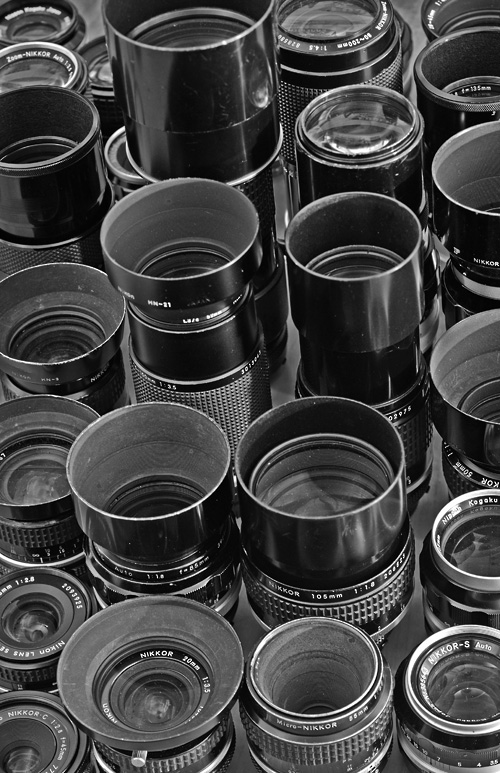
|
|
Old Nikon non-CPU lenses - useful or just rubbish?
|
Thanks to the consistency of Nikon's F-Mount many of the good old Nikkor lenses can be mounted onto our modern Nikon DSLRs (with restrictions to be discussed below). But is a DSLR in conjunction with an old manual-focus, non-CPU lens a reasonable combination?
The only MF lenses Nikon has launched over the last years were the PC-E T&S lenses. Otherwise every newer Nikkor is an AF-S lens. But this strategy leaves niches. Samyang, Voigtländer and especially Zeiss are successful in selling high-quality manual-focus lenses. The look and feel of a Zeiss lens is superb and they have a very good reputation in terms of optical performance. Nevertheless I would not spend a lot of money on any of the current Zeiss lenses. For example: according to several comparisons on the Web the Zeiss 15mm f/2.8 seems to be as good as the Nikkor 14-24mm f/2.8. But the Nikkor is a zoom, it has AF and it costs 1000 euros less! Because of similar reasons I would prefer the Nikkor 24mm f/1.4 over the Zeiss 25mm f/2 and so on. Moreover, for some of the Zeiss lenses there exist a used but cheap alternative: older MF-Nikkors. The build quality is on a very high level and optically most of them are solid performers including some really superb ones.
I own a couple of non-CPU Nikkors. Especially if I have to limit volume or weight, the old Nikkor glasses can be very helpful. For example: my Nikkor 20mm f/3.5 is a very good and lightweight replacement for the 17-35mm f/2.8. The Micro-Nikkor 55mm f/3.5 is a superb little lens that perfectly fills the gap between the 17-35mm and the 80-200mm.
Over the years I tried a lot of (manual focus) Nikkors, see my article subjective lens evaluations. I am still doing so. Currently I am trying an AI 24mm f/2.8 and an AI-S 105mm f/1.8. It is great fun for me!
In this article I assume you are planning to buy older Nikkors for using, not for collecting. You should own a Nikon DSLR or SLR with an AI-coupling. For my needs, DSLRs or newer SLRs with a CPU-interface only are not of interest here, because they don not allow exposure metering with non-CPU lenses. Older cameras from the pre-AI era (before 1977) are quite usable with the lenses discussed here, but they are a bit exotic and impractical from our present-day perspective, see my article "The wild early years".
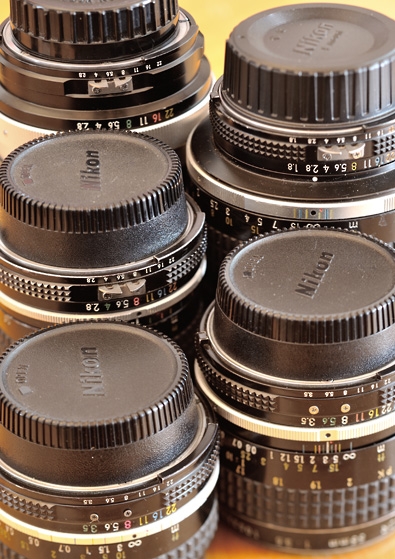
|
Even if you are an owner of a Df: buy AI oder AI-modified lenses. It is a nice feature of the Df to be able to work even with non-AI lenses. But the Df is the only camera with that feature. Later cameras (as of September 2014: D4s, D810 and D750) do not share it. If Nikon's retro-style DSLR line ends some day I guess the non-AI feature will end, too. Then you will have a problem with your non-AI lenses...
Furthermore, if you plan to buy an AI-modified lens I strongly recommend to choose only factory AI'd lenses! More details about AI conversions can be found in my article using older lenses on your Nikon DSLR.
In short: the MF-Nikkor you plan to buy should have an aperture ring with two aperture scales: one with bigger digits towards the front of the lens and one with smaller digits towards the camera, just like the five lenses to the left.
Nearly every MF-Nikkor was delivered with a coupling shoe. You only need it if you still use pre-AI cameras (built before 1977). Otherwise you can remove the shoe, maybe it is already removed from the lens you are interested in. The removal is easy: just screw out the two screws. But you should not leave the screw holes open, therefore carefully try to screw the two screws back in again. On some lenses that works, on others the screws are too long without the shoe and you will lock the aperture ring if you tighten them. In this case you can get proper screws from the Nikon service.
Of course, you know you can only use the A and M exposure modes and you do not have AF with a non-CPU lens.
But you should also know the more subtle restrictions.
Until 1996 you had to set the aperture with the aperture ring of the lens on every camera with an AI-coupling. The F5 was the first one that allowed to set the aperture over the new second command dial (but only for lenses with CPU). Five years later new Nikkor lenses no longer got an aperture ring (exceptions prove the rule). Roughly, we have a mix of three types of interfaces today:
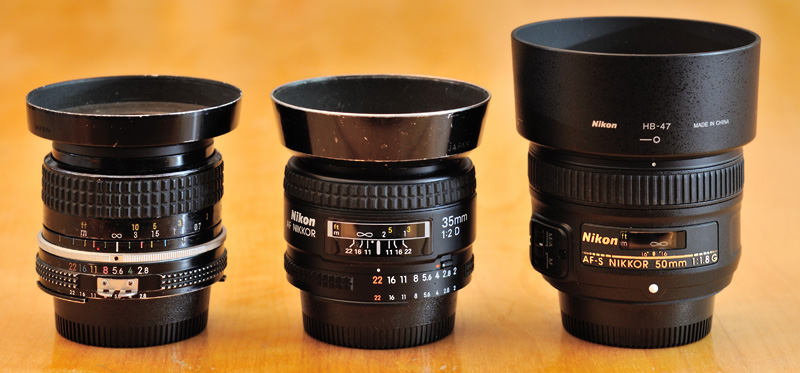
|
|
Simplified classification: 1. non-CPU lenses, 2. CPU lenses with aperture ring, 3. CPU lenses without aperture ring The old MF-Nikkor lenses (and Zeiss lenses with the "ZF"-Mount) belong to the non-CPU lenses. Older AF-Nikkors and AI-P lenses (like Zeiss lenses with the "ZF.2"-Mount) belong to the second group. AF-Nikkors that were introduced within the last 13 years belong to the third group. |
With a non-CPU lens you must use the aperture ring of the lens for controlling the diaphragm, but with a modern lens without an aperture ring you must use the command dial. Thus, if you use lenses of group 1 and 3 alternately you might have a handling problem, especially if you often exchange the lens. CPU lenses with aperture ring can be configured in the camera menus to use either the aperture ring or the command dial. Therefore a mix of lenses from group 1 and 2 or from 2 and 3 is easier to handle.
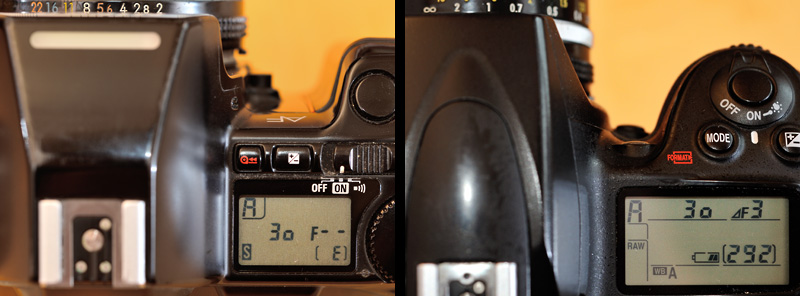
|
|
On the left the Nikon F-801 (in US: N8008) with a MF-Nikkor 35mm f/2: there is no information about the aperture in the displays. On the right the D700 with the same lens: the relative aperture value is displayed. |
The AI coupling on its own just transfers the relative aperture value from the lens into the camera. The early camera bodies with a combined CPU/AI interface only show "F--" in the display when a non-CPU lens is mounted. Today, our DSLRs are better here, they show the relative aperture value, for example a delta-F of 3 if you have a f/2 lens set to F5.6 (stopped down 3 stops). Matrix metering is not available here because the camera cannot determine the absolute brightness of your subject.
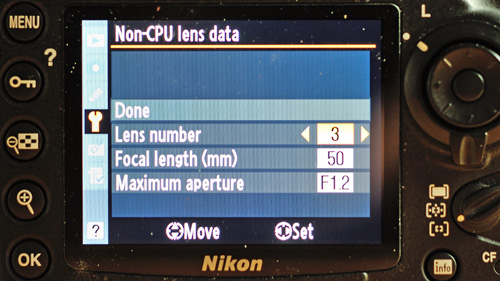
|
With the D2 series Nikon introduced the possibility to key in the lens speed. That enables matrix metering and the display of absolute aperture values. In the current DSLRs you can store the data (lens speed and focal length) of up to 9 non-CPU lenses. That is great, but please keep in mind: you must select another lens number when you exchange non-CPU lenses! That slows down the process a bit. It is a good idea to configure the selection of a non-CPU lens onto the "FUNC. button+dials" (see your camera's manual).
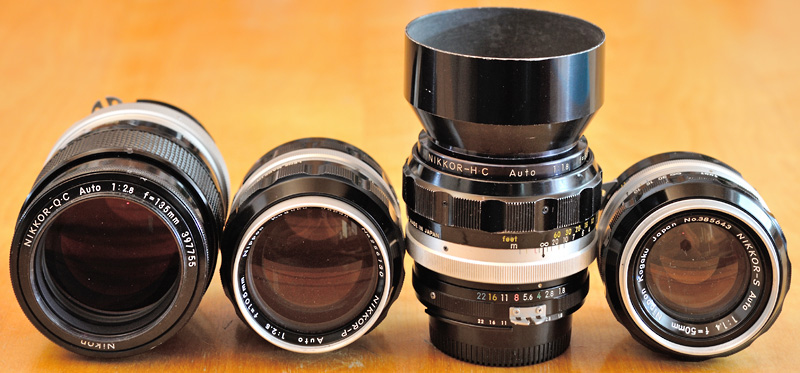
|
|
4-5-6-7 |
Between 1959 and about 1974 a Nikkor was not just a Nikkor, it was for example a "NIKKOR-H C Auto". What does that mean?
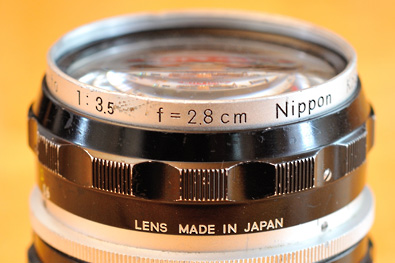
|
|
On the very early Nikkors the focal length was specified in cm.
|
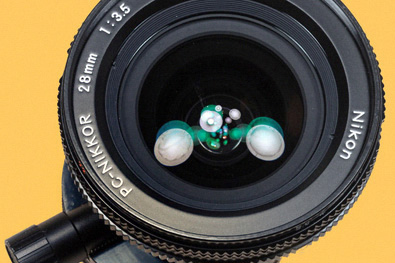
|
|
Don't get confused! This PC-Nikkor is a shift lens - "PC" stands for "perspective control". In contrast a "NIKKOR-P C" is a lens with five elements and an improved coating.
|
The first letter after the word "Nikkor" tells us the number of lens elements. It is the first letter of the Latin or Ancient Greek numeral:
If a lens had more than 10 elements, two letters were used. Example: the Nikkor-UD 20mm f/3.5 has 1+10=11 elements.
Of course, the number of lens elements is not really important. But in the earlier years it was a kind of quality attribute to have many lens elements.
The letter "C" is a very important one for you! It indicates the lens is multi-coated. Nikon began to provide the first lenses with the improved coating in 1972. If you photograph in visible light, you should prefer multi-coated lenses!
At last there is the word "Auto". It stands for automatic diaphragm which means the lens is stopped down automatically by a spring mechanism just after the camera's shutter release button was pressed. In the first years of the F Nikon had a few non-Auto telephoto lenses in their F-Mount lineup, which were derived from rangefinder lenses. Shift and mirror lenses are also examples for non-Auto lenses.
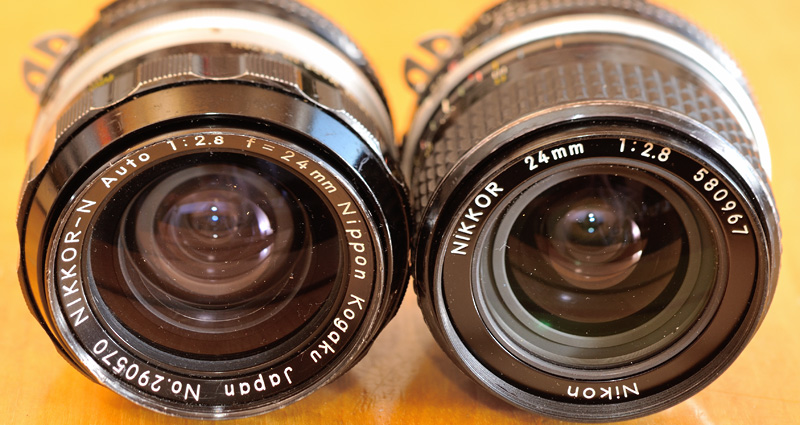
|
|
Nikkor 24mm f/2.8 from about 1970 and from about 1978. |
In the middle of the 70s Nikon simplified the lens designation. For example, a "NIKKOR-P C Auto 1:2.5 f=105mm " became a simple "NIKKOR 105mm 1:2.5".
Up to the early 70s the Nikkor lenses were labelled with "Nippon Kogaku Japan" and the serial number had the prefix "No.". Thereafter they were labelled simply with "Nikon" and the serial number had no longer a prefix.
If you want to determine the exact age of a Nikkor lens through its serial number, visit Roland Vink's great website (see my "links" section under Nikon history).
Over the years the Nikkor lenses varied in style. Up to the early 70s most Nikkors had full-metal focus rings. But a very few already got a rubberised ring in the 60s, for example the 135mm f/2.8, the second from the right in the image below. In 1977 - when the AI system was introduced - nearly every Nikkor had a rubberised focus ring. The early Nikkors had a lot of silver metal (see the leftmost lens in the image below). Later the front part with the filter thread was painted black. In the middle of the 70s the silver was reduced again: the fixed silver ring between aperture ring and focus ring became significantly smaller, see the rightmost lens below.
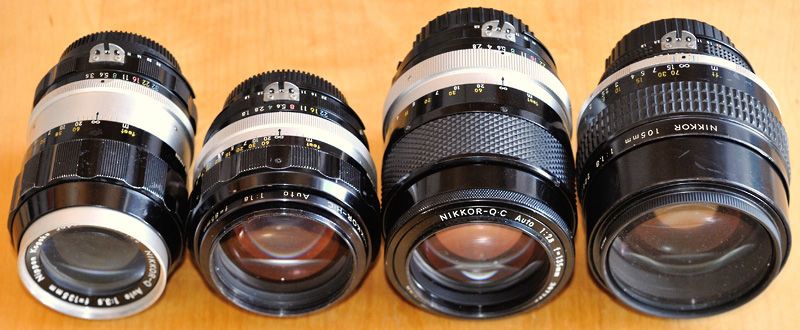
|
|
Examples for the evolution of the outer design. |
Independent from such outward details: the build quality of the MF-Nikkor lenses of all these generations is exceptionally high. They are built to last!
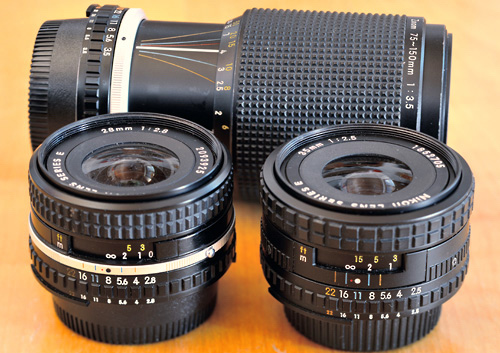
|
|
Nikon Series E lenses. Originally, these lenses were completely black. Later they got a Nikkor-like silver ring. |
In 1979 Nikon introduced the cheap EM camera and a series of cheap lenses, the "Nikon Series E" lenses. These lenses were available until 1985. Nikon offered five primes (28mm f/2.8, 35mm f/2.5, 50mm f/1.8, 100mm f/2.8 and 135mm f/2.8) and three zooms (36-72mm f/3.5, 75-150 f/3.5 and 70-210 f/4).
I tried all the primes and found them to be solid performers, although they have got a simpler coating than the Nikkors. But when it comes to build quality the five are clearly worse than the Nikkors. Today I use my Series E primes solely for UV- and IR-photography, where they perform very well.
The only Series E zoom I know is the 75-150mm. In contrast to the primes the build quality of it is very close to the Nikkor standard. Due to the very good optical performance and the compactness this zoom lens is highly recommended!
In the middle of the 90s Nikon introduced a budget MF product line produced by Cosina: the Nikon FM10 and the Nikon FE10 together with the Nikkor 35-70mm f/3.5-4.8 and the Nikkor 70-210mm f/4.5-5.6. I guess these two kit-lenses do not provide the usual MF-Nikkor build quality.
In my opinion it is important to mount the proper hood in front of the lens. The hood not only helps to minimise flare and ghosting, it is also a mechanical protection for the front element and it helps to keep raindrops away from it.
For the MF-Nikkors Nikon offered the following types of hoods:
For determining the proper lens hood the above-mentioned website of Roland Vink is very helpful again!
Many of the HN and HK hoods can be closed by a bigger lens cap, for example a 72mm cap fits perfectly onto the HN-1, HN-2 and HN-3 hoods. Especially for wide-angle lenses that helps to protect the front element when the lens is in your bag.
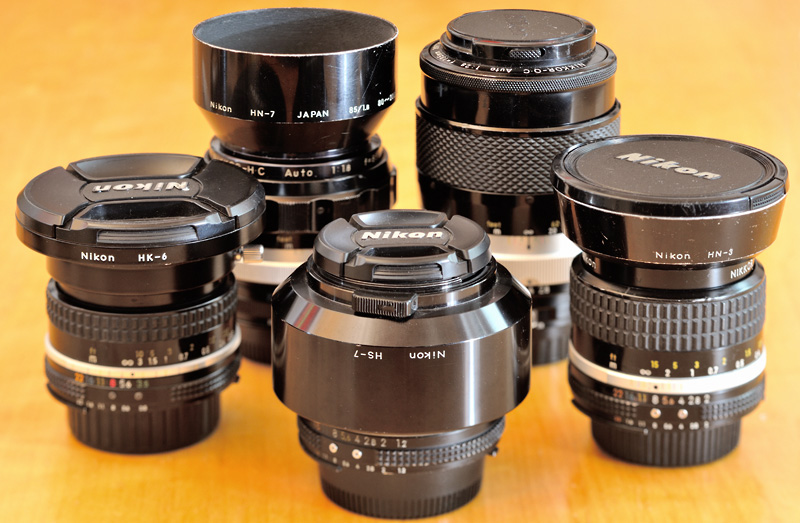
|
|
Lenses with hoods as I tranport them in my bag. If I take out one for photographing, I have the most effort with the HS type (in the foreground). But in terms of saving space the HS and the built-in hood (135mm f/2.8 in the background on the right) are the best. |
The best solution for telephoto lenses is a built-in hood, that just has to be pulled out. It saves space in the bag or in your pocket and the handling is faster than it is with an HS hood.
One of the Nikkor legends, the 105mm f/2.5 was delivered with multicoating starting in 1973. The optical formula of the lens was not modified between 1973 and the end of production in 2005. Thus, in terms of optical performance, you can buy any of the versions since 1973. But only the AI-S version (the last one, 1981-2005) of this lens has got a built-in hood, which makes the lens very compact. I would go for this version!
Nikon has used built-in hoods for focal lengths of 105mm or longer. Some of them can be fixed in the pulled-out position by screwing.
Have a look at the image below. The lens - a 24mm f/2.8 AI I bought a few month ago - shows heavy signs of use. But such a cosmetic condition should not prevent you from buying a lens!
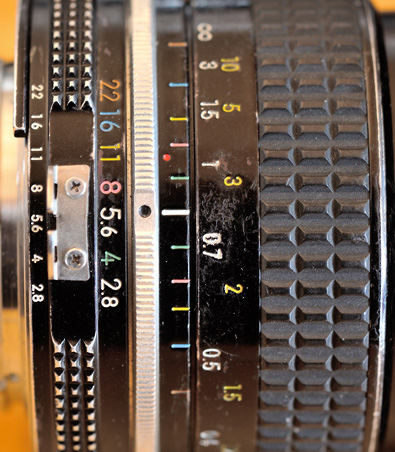
|
From my point of view visibly used MF-Nikkors have advantages:
More important than the cosmetic condition of the lens barrel is the glass itself.
Set the Nikkor to the smallest aperture value and look through it, if possible with a white background.
A little bit of dust inside the lens is normal, but there should not be any bigger specks. If the lens shows a significant colour cast, there is something wrong. Reasons can be a kind of plaque inside the lens on the surfaces of the lens elements or bad glass. I only know of one Nikkor lens with a bad glass problem: the early, non-multicoated samples of the 35mm f/1.4 from the early 70s. They used thorium glass in that lens which gets a strong yellowish cast over the years. Moreover it emits a weak nuclear radiation.
Now change to a contrasty background and look again through the lens (both, from the front and from the rear side). Do you detect any kind of haze? Then you should not buy this lens. The images of the background within the lens should appear clear!
Next you should inspect the front and rear lens element from a sloping position against the light. Do you see any damages? The glass should appear clear, not hazy!
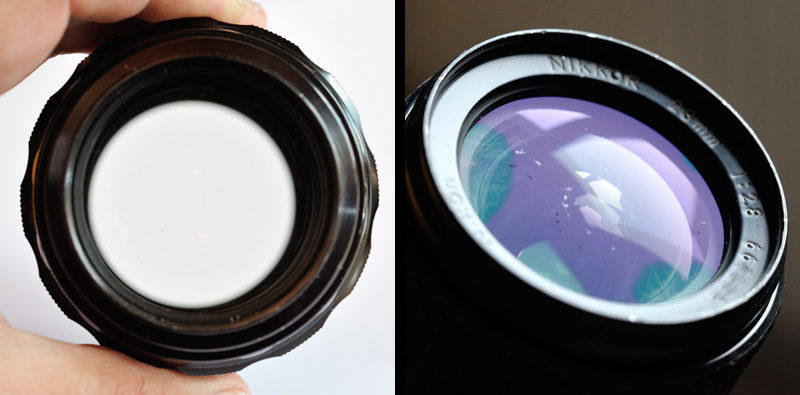
|
|
The lens on the left looks good: no bigger specks and no colour cast. On the right you see a lens with many problems: it has several damages on front element. Furthermore, these damages produce shadows on the backside of the front element. Thus, there is a kind of film on the surface. At last: the green areas consist of fungus. |
The lens mount of a new MF-Nikkor is silver. A lot of golden colour at the lens mount of a used lens is an indicator for frequent mounting and dismounting of the lens. In general, you should mount the lens onto a camera body for checking it fits tightly. But that is a must for a "golden" lens.
If the filter thread looks damaged, but the seller tells you it is ok, you should carefully try to screw in a filter. I would not use your newest filter for that!
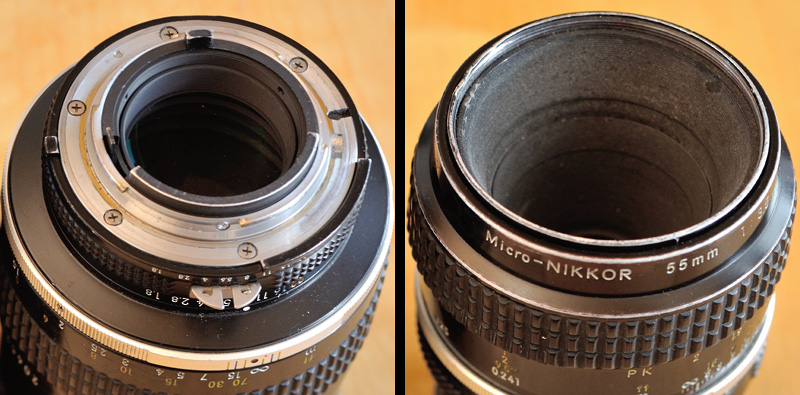
|
|
Although my 105mm f/1.8 shows a lot of gold at the mount it fits tightly on each of my camera bodies. The filter thread of the Micro-Nikkor on the right looks damaged but it is still usable. |
Do not forget to check the mechanics of a lens. Is the rotation of the aperture ring and of the focussing ring smooth, just as you like it? If it is a two-ring zoom lens you should also check the zoom ring. If it is a one-ring zoom check the push and pull mechanism. Often it is a bit too loose on an older zoom lens.
Another important point is the proper function of the diaphragm. Set the aperture to the greatest value (depending on the particular lens 16, 22 or 32). Then move the aperture lever a couple of times forth and back with your finger in order to vary the size of the aperture. The hole in the middle of the diaphragm should always look symmetrical!
Just before the shutter opens the camera stops down the lens. You must simulate it: open the aperture with your finger as described above. Then quickly pull away your finger. The aperture must be closed immediately (by a spring mechanism inside the lens). If there is a delay or the aperture blades move slowly, then the usage of the lens is problematical - probably, you will get overexposed and unsharp images.
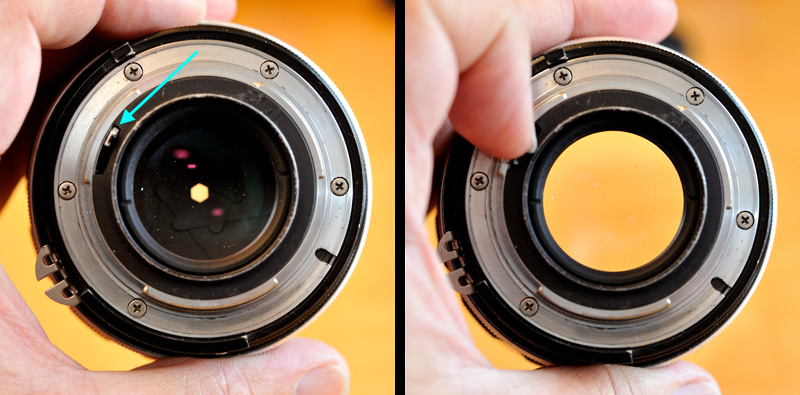
|
| With the aperture lever - see arrow - you can control the aperture and simulate the camera. |
Of course, the above-mentioned mechanical problems can be solved by the Nikon service, but you must keep the costs for such a service in mind for the negotiations for the puchase price...
You will find a lot of nice MF-Nikkors on ebay. But you should have a look at the windows of your local dealer, too. In my experience, prices there are not much higher than on ebay.
What to do if you bought a lens and you realise you don't like it? Don't worry, just resell it on ebay. I have tried a lot of lenses over the years. Most of them I resold, usually without a loss worth mentioning.
Enjoy!